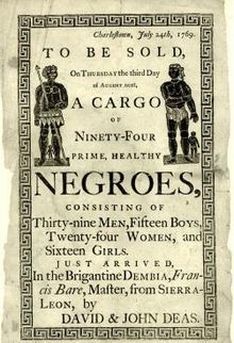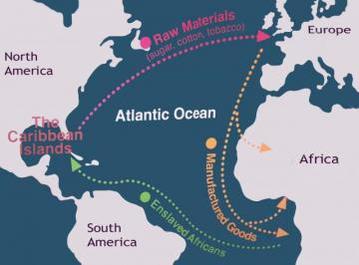The Slave Trade
This is also known as the triangular trade (see source 1.2), which functioned in the following way:
- Europeans purchased slaves who had been captured in Africa, then transported them by ship to the Americas to be sold as labourers to work on sugar-cane, cotton and tobacco plantations (see source 1.1).
- The raw materials from these plantations were then shipped back to Europe to be refined or sold in European markets.
- Some of the goods made from these raw materials (such as rum, textiles and manufactured goods) were then shipped to Africa to be sold in markets there. At this point, new slaves would be loaded and transported to the Americas again, continuing the cycle.
Previously the trade had been dominated by the Spanish and Portuguese. However, driven by profit, Britain became a major player in the slave trade during the 1700's. Merchant ships were happy with the slave trade because there ships were constantly full on each leg of the journey. Profit and a sense of European superiority, ensured that the slave trade grew rapidly. This trade lasted until 1833 in the British empire and 1863 in the United States.
It has been estimated that by the end of the 18th century that up to 12 million Africans had been taken as slaves. The enormity of this number for the slave trade was not just the result of the need for cheap labour, as the number and size of plantations in the Americas expanded. The amount of slaves transported from Africa to the Americas was also a result of the significantly high premature death rate among slaves. Meaning that more and more slaves were always needed to maintain the size of the workforce.
It has been estimated that by the end of the 18th century that up to 12 million Africans had been taken as slaves. The enormity of this number for the slave trade was not just the result of the need for cheap labour, as the number and size of plantations in the Americas expanded. The amount of slaves transported from Africa to the Americas was also a result of the significantly high premature death rate among slaves. Meaning that more and more slaves were always needed to maintain the size of the workforce.
The Middle Passage
The middle passage is perhaps the most notorious leg of the transatlantic slave trade. The middle passage refers to the section of the journey in which slaves were transported from Africa across the Atlantic ocean to the Americas. This journey lasted, on average, from one to three months depending upon the ship's port of departure and its destination. Other factors such as the weather and the living conditions on the ship also impacted upon the length of the journey.
The middle passage was notorious because of the living conditions the slaves had to endure aboard the ship. Profit had a significant impact upon the treatment of slaves aboard the ships. The best way of packing and shipping human cargo was often argued to be the most profitable way. So how were the slaves packed and shipped?
Two methods of transportation developed to address this:
The middle passage was notorious because of the living conditions the slaves had to endure aboard the ship. Profit had a significant impact upon the treatment of slaves aboard the ships. The best way of packing and shipping human cargo was often argued to be the most profitable way. So how were the slaves packed and shipped?
Two methods of transportation developed to address this:
- The Loose Pack Method: Basically the idea was to give the slaves a little extra room on board the ship. This would result in not as many slaves dying on the journey due to appalling living conditions. Those that survived would also arrive in better condition; therefore fetching a higher market price.
- The Tight Pack Method: In contrast to the loose pack, this method chose to load more slaves onto a single ship. More slaves meant that even if a few died on the journey or arrived in poor health there would still be plenty of slaves to sell.
Now watch this 5 minute video on the slave trade from Ted.Ed to find out more about how the transatlantic slave trade functioned. Use this video and the information above to help you answer the questions below.
Click on the 'Click Me!' button to the left to find out a bit more about how the slave ship companies packed their human cargo for shipment.
|
Activity 2: Database Research
For the next activity we are going to be accessing an interactive map of the Transatlantic slave trade which we give us a sense of the scale of the transatlantic slave trade across time, as we explore the movement of people out of Africa through the flow of transport and destinations.
|
What you have to do:
Don't worry if some information is missing from the database. Answer the questions as best as you can, remembering that it is often the case that historical sources can be lacking information and this is why we have to check our sources and validate the information we encounter. We'll be doing a bit more of this in latter lessons as we explore perspective and historical empathy in regards to the slave trade. |
|


